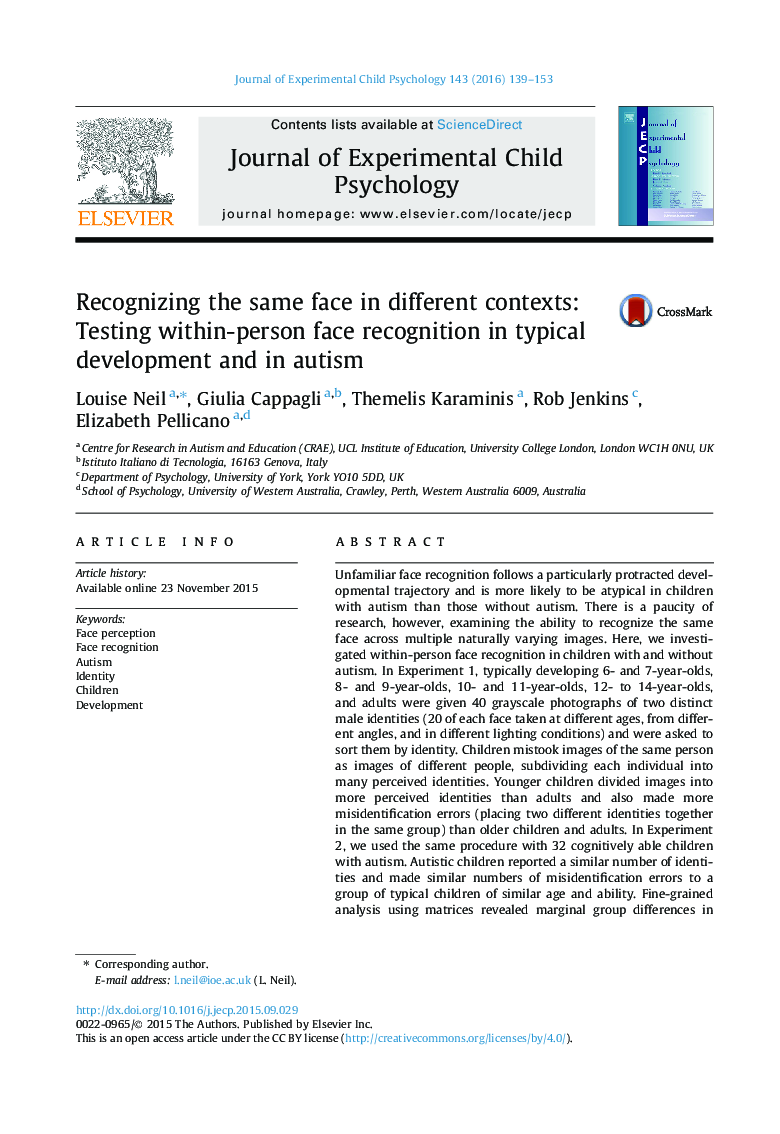| کد مقاله | کد نشریه | سال انتشار | مقاله انگلیسی | نسخه تمام متن |
|---|---|---|---|---|
| 7274761 | 1473469 | 2016 | 15 صفحه PDF | دانلود رایگان |
عنوان انگلیسی مقاله ISI
Recognizing the same face in different contexts: Testing within-person face recognition in typical development and in autism
ترجمه فارسی عنوان
تشخیص همان چهره در زمینه های مختلف: تست تشخیص چهره در داخل فرد در توسعه نوعی و در اوتیسم
دانلود مقاله + سفارش ترجمه
دانلود مقاله ISI انگلیسی
رایگان برای ایرانیان
کلمات کلیدی
ادراک چهره، تشخیص چهره، اوتیسم، هویت، فرزندان، توسعه،
ترجمه چکیده
تشخیص چهره نا آشنایانه به دنبال مسیری خاص برای رشد طولانی مدت است و بیشتر در کودکان مبتلا به اوتیسم غیرطبیعی است نسبت به افرادی که مبتلا به اوتیسم نیستند. با این حال، کمبود تحقیقات در حال بررسی توانایی تشخیص چهره یکسان در تصاویر مختلف متفاوت است. در اینجا، ما تشخیص چهره در داخل فرد را در کودکان مبتلا به اوتیسم بررسی کردیم. در آزمایش 1، به طور معمول 6- و 7 ساله، 8- و 9 ساله، 10- و 11 ساله، 12 تا 14 ساله، و بزرگسالان 40 عدد از عکس های خاکستری دو هویت مردانه مجزا (20 عدد از هر صورت در سنین مختلف، از زوایای مختلف و در شرایط روشنایی مختلف) و از آنها خواسته شد که آنها را با هویت مرتب سازند. کودکان تصاویری از همان شخص را به عنوان تصاویری از افراد مختلف به تصویر کشیدند و هر فرد را به چند هویت درک شده تقسیم کردند. کودکان جوانتر تصاویر را به هویت های درک شده تر نسبت به بزرگسالان تقسیم کرده و همچنین خطاهای اشتباه شناسایی (قرار دادن دو هویت مختلف در یک گروه مشابه) از کودکان و بزرگسالان بزرگتر. در آزمایش 2 ما از روش مشابهی با 32 کودک مبتلا به اوتیسم استفاده کردیم. کودکان مبتلا به اوتیسم تعداد مشابهی از هویت ها را گزارش کرده و تعدادی از اشتباهات شناسایی اشتباه را به یک گروه از کودکان معمولی از سن و توان سنین مشابه داده اند. تجزیه و تحلیل ضخامت دانه با استفاده از ماتریس ها، تفاوت های گروهی حاشیه ای را در عملکرد کلی نشان داد. ما پیشنهاد می کنیم که عملکرد نابالغ در کودکان معمول و اوتیسم می تواند از مشکلات استخراج مشترکات ادراکی از تصاویر مختلف یک شخص و ایجاد نمایه های پایدار هویت چهره جلوگیری کند.
موضوعات مرتبط
علوم انسانی و اجتماعی
روانشناسی
روانشناسی رشد و آموزشی
چکیده انگلیسی
Unfamiliar face recognition follows a particularly protracted developmental trajectory and is more likely to be atypical in children with autism than those without autism. There is a paucity of research, however, examining the ability to recognize the same face across multiple naturally varying images. Here, we investigated within-person face recognition in children with and without autism. In Experiment 1, typically developing 6- and 7-year-olds, 8- and 9-year-olds, 10- and 11-year-olds, 12- to 14-year-olds, and adults were given 40 grayscale photographs of two distinct male identities (20 of each face taken at different ages, from different angles, and in different lighting conditions) and were asked to sort them by identity. Children mistook images of the same person as images of different people, subdividing each individual into many perceived identities. Younger children divided images into more perceived identities than adults and also made more misidentification errors (placing two different identities together in the same group) than older children and adults. In Experiment 2, we used the same procedure with 32 cognitively able children with autism. Autistic children reported a similar number of identities and made similar numbers of misidentification errors to a group of typical children of similar age and ability. Fine-grained analysis using matrices revealed marginal group differences in overall performance. We suggest that the immature performance in typical and autistic children could arise from problems extracting the perceptual commonalities from different images of the same person and building stable representations of facial identity.
ناشر
Database: Elsevier - ScienceDirect (ساینس دایرکت)
Journal: Journal of Experimental Child Psychology - Volume 143, March 2016, Pages 139-153
Journal: Journal of Experimental Child Psychology - Volume 143, March 2016, Pages 139-153
نویسندگان
Louise Neil, Giulia Cappagli, Themelis Karaminis, Rob Jenkins, Elizabeth Pellicano,
